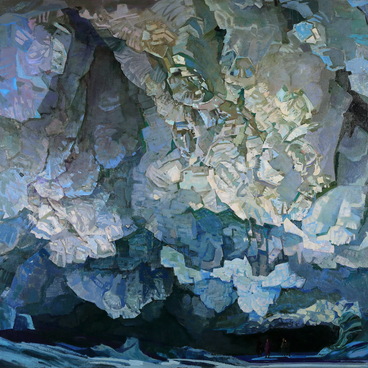Vladimir Chursin had his own unique manner of painting. In his paintings, he created an unusual world that immersed the viewers into the atmosphere of parades and solemn marches, beauty contests, and Parisian variety shows. The imagery of a nude female figure occupies a special place in the painter’s oeuvre. Chursin also worked in the genre of still life. His works include those where he arranged art elements of different eras by combining fictional, literary, and historical characters, as well characters from paintings by various artists, all on one canvas. “Velázquez”, depicting the famous Baroque artist, is one such work.
Diego Rodríguez de Silva y Velázquez specialized in mythological and historical paintings, genre scenes, and portraits. The artistic legacy of Velázquez is considered the pinnacle of Spanish painting of the 17th century and one of the brightest phenomena of world art.
In 1623, Diego Velázquez became the court painter to King Philip IV of Spain. He painted around thirty images of the sovereign, as well as numerous images of the infantes and heirs.
Vladimir Chursin created the painting “Velázquez” based on the self-portrait of the painter, which can be found in the work called “Las Meninas” (Spanish for “the ladies-in-waiting”, the entourage of the little infanta). The original painting is extremely valuable and famous and is kept in the Museo del Prado in Madrid. The image is set in one of the palace premises, provided by the king as a studio for Velázquez. The characters, plot, and composition of “Las Meninas” are still the subject of controversy among art historians around the world. On the surface, it may seem that the artist depicted the Infanta Margaret surrounded by ladies-in-waiting. However, this is not entirely true.
Velázquez painted this picture from the perspective of those posing for the artist. The king and queen are not active participants in the painting, there is only their vague reflection in the mirror on the back wall. However, it is believed that the painting shows their view of the scene and that the little Infanta Margaret, surrounded by ladies-in-waiting and little people, is called upon to entertain her parents while Velázquez is painting them.
Velázquez depicted himself standing near the left side of a large canvas and painting a portrait of the royal couple.
Vladimir Chursin used this image in his work. He reproduced separate details of the original painting and preserved a certain pictorial resemblance to the image of Velázquez, and yet managed to add his unique personal touch to the painting.
Diego Rodríguez de Silva y Velázquez specialized in mythological and historical paintings, genre scenes, and portraits. The artistic legacy of Velázquez is considered the pinnacle of Spanish painting of the 17th century and one of the brightest phenomena of world art.
In 1623, Diego Velázquez became the court painter to King Philip IV of Spain. He painted around thirty images of the sovereign, as well as numerous images of the infantes and heirs.
Vladimir Chursin created the painting “Velázquez” based on the self-portrait of the painter, which can be found in the work called “Las Meninas” (Spanish for “the ladies-in-waiting”, the entourage of the little infanta). The original painting is extremely valuable and famous and is kept in the Museo del Prado in Madrid. The image is set in one of the palace premises, provided by the king as a studio for Velázquez. The characters, plot, and composition of “Las Meninas” are still the subject of controversy among art historians around the world. On the surface, it may seem that the artist depicted the Infanta Margaret surrounded by ladies-in-waiting. However, this is not entirely true.
Velázquez painted this picture from the perspective of those posing for the artist. The king and queen are not active participants in the painting, there is only their vague reflection in the mirror on the back wall. However, it is believed that the painting shows their view of the scene and that the little Infanta Margaret, surrounded by ladies-in-waiting and little people, is called upon to entertain her parents while Velázquez is painting them.
Velázquez depicted himself standing near the left side of a large canvas and painting a portrait of the royal couple.
Vladimir Chursin used this image in his work. He reproduced separate details of the original painting and preserved a certain pictorial resemblance to the image of Velázquez, and yet managed to add his unique personal touch to the painting.



